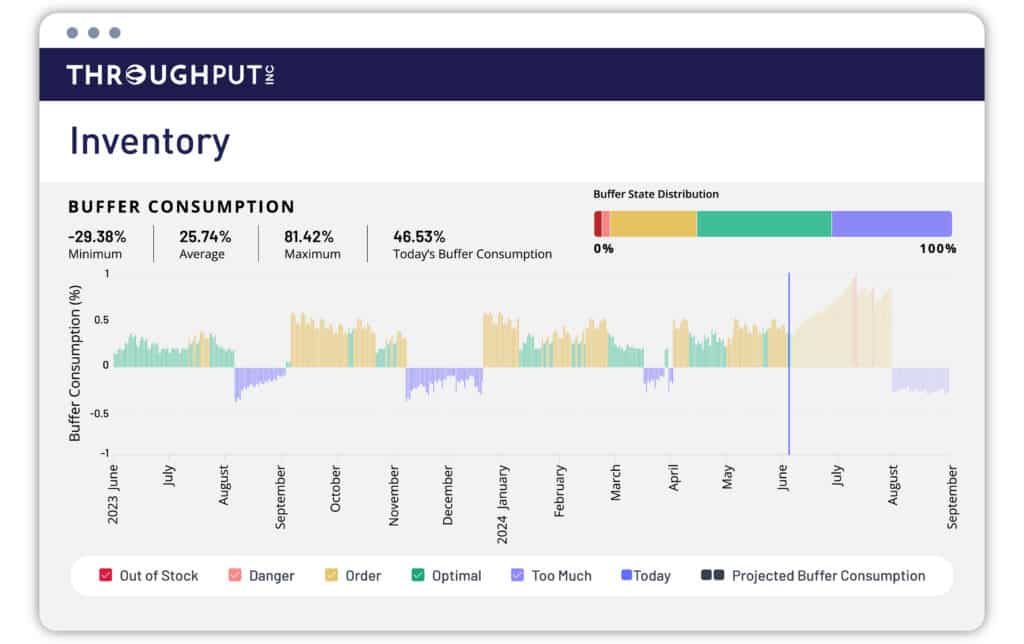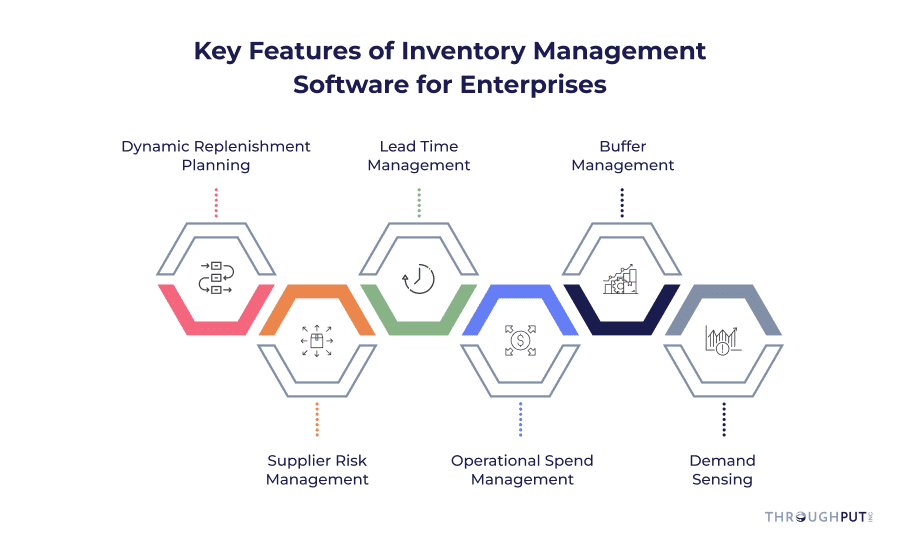Best Inventory Management Software for Enterprise Businesses

The health of your business is directly proportional to the health of your inventory. Both excess and depleting inventory can negatively impact your revenue.
No matter how familiar you may be with managing inventory manually or using multiple disparate systems, it’s not the most effective approach—especially when Artificial Intelligence (AI) and Machine Learning (ML) are already delivering phenomenal results across various other industries.
The best inventory management software, powered by these advanced technologies, can not only assist you with daily tasks but also support business-level strategic planning.
In this article, we’ll explore the top inventory management software with AI capabilities for enterprises in 2024.
What Is a Modern Inventory Management Software?
Gone are the days of inventory management systems that needed manual updates with limited integration capabilities.
Today, with the rapid evolution of technology, modern inventory management software comes with advanced capabilities like real-time tracking, automated replenishment planning, alerts for stockouts, analytics and reporting, multi-channel management and so much more – the right combination of intelligence, automation and, experience.
Best Inventory Management Software for Enterprises in 2024
1. ThroughPut AI: For Real-time Inventory Control & Operational Spend Management

Recognized as a Leading Vendor in the 2023 Gartner Market Guide for Analytics and Decision Intelligence in Supply Chain, ThroughPut AI is powered by its highly advanced patented algorithms, helping in end-to-end inventory management.
The tool offers actionable recommendations alongside visibility, to facilitate optimized decision-making. Built to enable users across the supply chain with insights, ThroughPut AI inventory management software is used for making operational and business-critical decisions, producing faster returns (ROI), and easing up the implementation process.
Main features
- Demand-driven replenishment planning of each SKU
- Dynamic lead time management
- Predict order cancellation opportunities
- Real-time buffer management
- Supplier risk management
- Optimize operational capital spend
Main Benefits
- Works with stakeholder’s existing data
- ROI in 90 days
- Granular visibility into the location, SKU, product portfolio, etc.
- Demonstrates business impact through financial view
2. Oracle Netsuite
A cloud-based inventory planning software, Oracle Netsuite is effective for businesses of all sizes and scales. It is integrated effortlessly with existing Oracle systems, offering a scalable and flexible ecosystem to support a range of inventory management needs.
Main features
- Comprehensive reporting
- Cycle counting
- Multi-location fulfillment
Main benefits
- Scalability features support business expansion.
- Fully integrates with other Oracle applications like finance, CRM, and e-commerce
3. Kinaxis
Another provider of cloud-based inventory management and supply chain solutions, Kinaxis, with its advanced analytics and real-time data integration helps businesses optimize their inventory levels. It helps make swift and informed decisions..
Main Features
- Lead time management
- Safety stock recommendations
- Customized alerts for order processing and inventory replenishment
Main Benefits
- Cross-functional collaboration
- An array of other tools in the Kinaxis ecosystem to choose from
4. IBM
IBM with a robust inventory visibility solution helps streamline and enhance the management of maintenance, repair, and operations (MRO) inventory. This solution is particularly beneficial for industries with complex supply chains and high-value inventory, such as manufacturing, aerospace, and utilities.
Main Features
- Scenario simulation
- AI-recommended changes
- Extensive reporting and analysis
Main Benefits
- Easy integration within IBM environment
- Interactive visualizations and insights
5. Blue Yonder
Blue Yonder is a comprehensive inventory optimization solution that aligns inventory planning, inventory strategy, and inventory execution with your strategic business goals for service, production, and distribution.
Main Features
- Dynamic segmentation
- Multi-echelon inventory optimization
Main Benefits
- Real-time inventory visibility
- Scalability of the tool
6. GMDH Streamline
GMDH Streamline is a demand forecasting and inventory planning software designed to help businesses optimize their inventory levels and improve supply chain efficiency. Built particularly for ecommerce, retailers, manufacturers and distributors, Streamline offers timely forecasts to drive better inventory management.
Main Features
- AI-powered demand forecasting
- Safety stock management
- Order management
Main Benefits
- Pay-as-you-go subscription model
- 1-4 weeks implementation timeline
7. Veeqo
Veeqo helps businesses manage stock across multiple sales channels, including Amazon, eBay, and Shopify. With real-time inventory syncing, order management, and shipping automation, it prevents overselling and stockouts while streamlining operations.
Main Features
- Instant alerts when the stock levels go low
- e-Commerce module to help with shipping customer orders
- Live warehouse dashboard that works as a command center for your warehouse-related processes.
- A digital Inventory management system with handheld barcode scanner
Main Benefits
- Scalable solution to start small without paying for expensive updates
- Sync inventory across multi-location and multi-marketplaces
- Automated workflows with customized triggers so that repetitive tasks can be put on autopilot
8. Logility
InventoryAI+ from Logility helps identify, and optimize inventory strategies across the supply chain network. The tool uses Strategic Scenario Modeling to understand the intricacies of your inventory landscape with alternate design scenarios.
Main Features
- Utilizes machine learning and data analytics for advanced demand forecasting
- Provides a platform for seamless communication between departments and with suppliers
- Balances inventory levels by optimizing safety stock and reorder points
- Offers real-time data analysis to identify trends and opportunities
Main Benefits
- Helps reduce stockouts and excess inventory, improving customer satisfaction and service levels
- Enhances communication, leading to better coordination and faster response times
9. Manhattan Associates
Manhattan Active® Store Inventory and Fulfillment is a new-age inventory management solution created to streamline retail operations and enhance customer experiences.
Main Features
- Order fulfillment feature facilitates in-store pickup, fleet delivery, same-day courier, curbside pickup, locker pickup, and parcel ship
- Push notifications for new orders, minimized abandonment, and direct communication
- Order-wise, batch-wise, team-wise picking and pick-to-slot for customized picking
- RFID-enabled optimization of pick path
Main Benefits
- Optimized picking means less time in searching for items
- Precise inventory accuracy facilitates faster pick-up time
- Better store health and employee performance with real-time visibility.
- Identify at-risk and high-priority orders
10. Palantir
Palantir offers a granular visibility into the supply chain network, while integrating different operational systems.
Main Features
- Integrates data from different sources in real-time. This offers an end-to-end visibility into inventory across the chain
- Customizable dashboards for better tracking and monitoring
- Provide predictive alerts to reduce operational downtime and reduce stock degradation
- Real-time data visibility for data-driven decisions
Main Benefits
- AI-powered analytics help optimize stock levels based on operational data and market trends
- Risk mitigation to minimize disruptions in the supply chain
- Reduce storage costs with stockout-related revenue losses
- Reduced downtime with predictive maintenance alerts
Why Is Decision Intelligence a Key Capability of Inventory Management Software?
Decisions are at the heart of inventory management. One wrong decision, whether at the operational or strategic level, can ripple across the entire supply chain and organization.
Inventory management software with decision support capabilities analyzes vast amounts of data that manual methods can’t handle, identifying patterns and trends to aid more accurate decision-making.
From determining when to order, what to order, and which SKUs to deprioritize, a decision intelligence system guides you in taking the right steps at every stage.
Take the case of ThroughPut AI. When inventory levels exceed recommended ranges, the tool alerts you, providing comprehensive visibility into future order requirements. Consequently, unnecessary orders can be canceled proactively until stock levels return to normal, aligned with optimal recommendations. This prevents overstocking, reduces inventory holding costs, and saves money while improving efficiency.
Decision intelligence bridges the gap between strategic decisions and operational processes. Predictive analytics and actionable recommendations are synchronized to achieve long-term plans and complete day-to-day activities. Thus, inventory management transforms from a static process into a responsive one, enabling businesses to operate more efficiently and profitably.
Key Features of Inventory Management Software for Enterprises

1. Dynamic Replenishment Planning
The best inventory planning software must be able to automatically adjust replenishment orders based on real-time data and demand forecasts, helping prevent stockouts and overstocking, improving efficiency, and reducing costs.
2. Supplier Risk Management
An enterprise-level inventory planning software should be able to monitor supplier performance and assess risks proactively. You should be able to identify potential issues and contribute towards making your supply chains more robust and reliable while ensuring that production and delivery schedules stay consistent.
3. Lead Time Management
The inventory management planning software should help you track and analyze the duration between placing the order to delivery. This way your procurement procedures are optimized with minimized delays and improve the efficiency of the supply chain, overall.
4. Operational Spend Management
Businesses must be able to track and control expenses of inventory procurement and storage. The software should provide intricate insights into spending patterns, helping you and your finance team with budget management and strategizing cost reduction.
5. Buffer Management
The best inventory planning software will have features that help you manage buffers helping maintain optimal safety stock levels. The feature also helps safeguard your inventory from demand variabilities and supply chain disruptions, like supply delays or unexpected demand spikers, ensuring smooth operations of your business.
6. Demand Sensing
This is one of the most helpful features of an inventory management software. It combines real-time data and predictive analytics to help in accurate demand forecasting. This allows businesses to respond swiftly to market changes, aligning inventory levels with actual customer demand.
What Are the Benefits of AI-powered Inventory Management Software Like ThroughPut AI?
- Accuracy
The right software for inventory management minimizes human errors and augments human decision-making.
Thus, there are minimal discrepancies which, in turn, boosts product availability at the right time, right place, and at the right price, improving customer satisfaction levels.
- Cost Savings
Excess stock levels and obsolete inventory that use up your valuable space in the warehouse result in wastage, incurring high costs.
One of the biggest advantages that a business can derive from implementing the best inventory planning software is reducing carrying costs by optimizing stock levels. With better inventory and stock management, resource allocation and utilization improve, storage expenses are reduced.
- Improved Operations
Your day-to-day tasks are automated including jobs like order processing, inventory tracking, and stock replenishments. Inventory management software is made easy, by streamlining operations. This improves operational efficiency and reduces redundancy.
- Better Demand Forecasting
Accurate demand prediction and forecasting can offer a key competitive advantage to businesses using the best inventory planning software.
With the help of predictive analytics and historical data, long-term and near-term demand can be forecasted with almost 100% accuracy. The upfront benefit is that with effective demand forecasting, you can plan your inventory purchases realistically and more efficiently, minimizing risks associated with stockouts and excess inventory.
- Real-time Data Access
The benefit of inventory planning systems powered by advanced technologies is that they offer real-time visibility into data and updates across multiple locations helping make well-informed and prompt decisions.
The software helps trace and locate SKUs in real time.
This responsiveness makes businesses agile to market changes, empowering them to meet customer demands with minimal disruptions.
- Scalability and Flexibility
Lastly, the best inventory planning software helps grow your business and build the brand name.
The scalable software accommodates increasing inventory volumes and the changing needs of the market. Thus, a one-time investment helps drive long-term efficiency, supporting the business during its expansion.
Best Practices: How to Implement an Inventory Management Software?
Ensure the tool gives a common operating view
The best inventory planning software should have a centralized dashboard for all stakeholders. Select one that offers unified visibility to all regarding real-time inventory and stocks, facilitating transparency and enhanced decision-making.
Granular view of inventory levels
Ensure that the software system you choose can track the items in your inventory in real-time allowing you to monitor stock levels as it is. This improves accuracy in managing your inventory and effectively prevents overstocking or stockout situations.
Should be scalable
Select a solution that can be sized up as the business grows. Scalability means that increasing inventory sizes and volumes with changing business needs translates into business efficiency and cost-effectiveness.
Works with existing data to see faster ROI
Go in for a software solution that can be integrated with your current data systems without disrupting your operations. You need to deploy faster and connect seamlessly with the improved chances of achieving ROI faster by leveraging existing data.
Aligns with business KPIs
Select a system that supports your overall organizational goals and key performance indicators (KPIs). Alignment with the business goals is a must because it helps track and measure performance effectively, with better outcomes.
Ease of use
Lastly, focus on the user-friendliness of the software so that there’s minimal resistance to change and a quicker adoption rate amongst end users. The best inventory planning software will have an intuitive interface so that time user acceptability and productivity are enhanced.
Case Studies of Inventory Management Software
Case Study 1: A Fast-Growing Coffee Retail Chain Optimized its Inventory with ThroughPut AI
A boutique coffee retail chain, operating for 10 years and specializing in locally grown, fair-trade, organic coffee and beverages, registered remarkable growth after implementing ThroughPut AI, a leading inventory management software. The chain, known for hand-brewed coffees, fresh juices, and smoothies, sought to streamline operations as it expanded into multiple locations.
Challenges
As the chain expanded, it faced critical challenges with inventory management, including:
- Inventory Pile-Ups and Overstocking: Excess inventory led to dead stock, resulting in food wastage and tied-up capital.
- Inefficient Shipping: High shipping costs and excessive fuel consumption were driving up operational expenses.
- Limited Product Visibility: The chain needed better insights into product performance to match its menu with evolving customer preferences and market trends.
Solution
ThroughPut’s advanced inventory management module provided the chain with data-driven solutions for optimizing its inventory and operations.
- Intelligent Product Optimization: ThroughPut analyzed historical sales data and inventory turnover to optimize the product mix, ensuring the right products were available at the right time.
- Near-Term Demand Sensing: The software enabled the chain to accurately forecast demand, reducing overstock and minimizing food wastage by adjusting menu offerings to match real-time market trends.
- SKU-Level Visibility: ThroughPut offered deep insights into SKU performance, allowing the chain to prioritize high-demand items and phase out underperforming products using a demand-value matrix.
- Lead Time and Shipping Efficiency: By assessing lead times and shipping costs, ThroughPut enabled the chain to make smarter sourcing decisions, reducing excess inventory and optimizing raw material shipments.
Impact
After adopting ThroughPut AI, the coffee chain experienced significant improvements across its operations:
- Dynamic Demand Adaptation: The chain became highly responsive to shifting customer demands, adjusting inventory and menus without operational disruptions or financial losses.
- Enhanced Operational Control: With SKU-level visibility and real-time data, the chain gained full control over material movement and inventory across all locations, ensuring the availability of fresh ingredients while minimizing waste.
- Streamlined Value Chain: ThroughPut empowered the chain to deliver the right products at the right time, improving cash flow and maintaining a competitive edge in the market.
Results Achieved
- 15% Reduction in Inventory
- 5% Productivity Gain in Labor
Case Study 2: A European Retail Behemoth Could Effectively Save Through Logistics Optimization
A 65-year-old European retail chain, offering over 15,000 products across various categories, was one of the first in its region to embrace organic products and online shopping. Despite its success and innovative approach, the chain faced increasing operational challenges, particularly in adapting to demand fluctuations and high logistics costs. ThroughPut’s AI-powered inventory management module provided the perfect solution, enabling intelligent product mix optimization that significantly improved margins and reduced operational inefficiencies.
Challenges
- Data-driven demand insights: The company struggled to gain a clear, data-driven view of customer demand impacting operational efficiency and customer satisfaction.
- SKU management issues:The client lacked visibility into low-value SKUs, leading to overstocking of low-demand items while failing to prioritize high-margin products.
- Escalating logistics costs: With inefficient stock replenishment and high demand volatility, the company was experiencing expensive expedited deliveries with high logistics costs.
Solution
- Demand Sensing & Product Mix Optimization: ThroughPut’s AI analyzed the client’s historical sales data and provided real-time demand sensing at the SKU level, helping the company eliminate underperforming SKUs and optimize its product mix for higher profitability.
- Streamlined Inventory & Logistics: The tool enabled SKU optimization reducing the need for costly, unplanned deliveries. ThroughPut’s AI enabled smarter stock replenishment and targeted distribution, improving overall logistics efficiency.
Impact
- Margin Increase by €30 Million with dynamic adaptation to demand shifts.
- SKU Optimization helped identify 200 low-demand SKUs and top-selling 150 SKUs, saving up to €2 million in savings.
- Reduction in logistics costs with an additional bottom-line impact of €10 million per facility.
How to Evaluate Inventory Management Software for Small vs. Large Businesses?
Evaluating inventory management software requires a tailored approach, as small businesses and large enterprises have distinct needs. Here’s a guide to help assess the right solution for each.
1. Small Businesses
The key considerations while choosing the best inventory management software in your case should be:
Budget Considerations
Focus on solutions that are cost-effective while still providing essential functionality. Choose software with flexible pricing models that can scale as the business grows. Take advantage of free trials or freemium versions to test the software’s features before committing.
User-Friendliness
Prioritize systems with a simple, easy-to-use interface and intuitive dashboards. Opt for software that has a minimal learning curve, reducing the need for extensive training. Consider cloud-based platforms that can be accessed through web browsers and mobile devices for flexibility.
Core Functionality
Focus on basic yet essential features such as real-time inventory tracking, order management, and basic reporting. Ensure the software is suitable for your current inventory size and the types of products you manage. Look for basic integration with e-commerce platforms and accounting software to streamline operations.
Flexibility and Customization
Select a solution that can adapt to your unique processes and workflows. Seek out software with customizable fields, templates, and reports to suit your specific needs. Ensure the system can support various product types, barcodes, and serial numbers for efficient tracking.
2. Large Businesses
The following criteria should be considered for larger businesses.
Comprehensive Features
Prioritize software with advanced features, such as supply chain management and multi-location inventory tracking. Ensure the system supports complex processes like drop shipping, kitting, and other specialized operations. Look for modular software that allows you to activate additional features as your business requirements evolve.
Scalability and Performance
Choose a solution that can manage high transaction volumes and large datasets without performance issues. Ensure it can support multiple warehouses and complex inventory structures across locations. Look for robust API support and integration capabilities with existing enterprise systems.
Advanced Analytics and Reporting
Opt for software that offers detailed insights through predictive analytics and custom reporting. Ensure it provides real-time data and customizable dashboards for tracking key metrics. Make sure the software can generate advanced reports to aid in strategic decision-making.
Security and Compliance
Evaluate the system’s security features, such as role-based access controls, data encryption, and audit trails. Ensure the software complies with relevant industry regulations and standards. Look for features like detailed activity logs to maintain transparency and accountability.
Enterprise-Level Support
Consider the availability of dedicated account managers to assist with large-scale implementations. Look for vendors offering 24/7 customer support and clearly defined service level agreements (SLAs). Evaluate the vendor’s track record with successfully supporting large, complex operations.
Common Considerations for All Businesses
Regardless of size, both small and large businesses should consider the following:
- Integration capabilities with existing systems, such as ERP or e-commerce platforms.
- Mobile accessibility to manage inventory on the go.
- Cloud-based versus on-premise deployment options, depending on your infrastructure.
- The vendor’s reputation, long-term viability, and customer reviews to gauge reliability
FAQs
- How is inventory planning software different from warehouse management software?
Inventory planning software is primarily used for optimizing stock levels, and replenishing inventory based on sales data, demand forecasts, and trends.
Warehouse management software is a tool that helps manage the day-to-day operations within a warehouse, including inventory storage, picking, packing, and shipping.
While the former ensures you have the right products, the latter ensures those products are efficiently handled and dispatched.
- What are the advantages of using ThroughPut AI?
ThroughPut is an AI-based supply chain intelligence tool that offers holistic advantages in inventory planning and management.
You start to see faster return on investment, within 90 days.
The tool offers granular visibility into SKU levels, helping you with decision-making.
The tool also offers clear business impact and financial clarity to all stakeholders in understanding value add-ons.
- ThroughPut AI’s inventory management suitable for retail?
Yes, ThroughPut’s inventory management suite can be utilized in multiple industries and segments like retail, F&B, military, supermarkets, cement, and others.
- What is the difference between an ERP and an inventory management software?
ERP or Enterprise Resource Planning software is a comprehensive system helping integrate and manage all core business processes including key gamuts of the organization like finance, HR, supply chain, etc.
Inventory management software specifically helps you optimize inventory levels, ensuring that the stock levels are efficiently managed.
The former helps you manage operations holistically while the latter helps with inventory-specific needs.


